Factors Influencing Pseudo-Accommodation—The Difference between Subjectively Reported Range of Clear Focus and Objectively Measured Accommodation Range
Abstract
1. Introduction
2. Materials and Methods
3. Results
4. Discussion
5. Conclusions
Author Contributions
Funding
Conflicts of Interest
References
- Wold, J.E.; Hu, A.; Chen, S.; Glasser, A. Subjective and objective measurement of human accommodative amplitude. J. Cataract Refract. Surg. 2003, 29, 1878–1888. [Google Scholar] [CrossRef]
- Ostrin, L.A.; Glasser, A. Accommodation measurements in a prepresbyopic and presbyopic population. J. Cataract Refract. Surg. 2004, 30, 1435–1444. [Google Scholar] [CrossRef] [PubMed]
- Glasser, A. Accommodation: Mechanism and measurement. Ophthal. Clin. North Am. 2006, 19, 1–12. [Google Scholar]
- López-Gil, N.; Martin, J.; Liu, T.; Bradley, A.; Díaz-Muñoz, D.; Thibos, L.N. Retinal image quality during accommodation. Ophthal. Physl. Opt. 2013, 33, 497–507. [Google Scholar] [CrossRef] [PubMed]
- Marcos, S.; Moreno, E.; Navarro, R. The depth-of-field of the human eye from objective and subjective measurements. Vis. Res. 1999, 39, 2039–2049. [Google Scholar] [CrossRef]
- Wang, B.; Ciuffreda, K.J. Depth-of-focus of the human eye: Theory and clinical implications. Surv. Ophthal. 2006, 51, 75–85. [Google Scholar] [CrossRef] [PubMed]
- Wolffsohn, J.S.; Hunt, O.A.; Naroo, S.A.; Gilmartin, B.; Shah, S.; Cunliffe, I.A.; Benson, M.T.; Mantry, S. Objective accommodative amplitude and dynamics with the 1CU accomodative intraocular lens. Investig. Ophthalmol. Vis. Sci. 2006, 47, 1230–1235. [Google Scholar] [CrossRef]
- Vasudevan, B.; Ciuffreda, K.J.; Wang, B. Subjective and objective depth-of-focus. J. Mod. Opt. 2007, 54, 1307–1316. [Google Scholar] [CrossRef]
- Win-Hall, D.M.; Glasser, A. Objective accommodation measurements in pseudophakic subjects using an autorefractor and an aberrometer. J. Cataract Refract. Surg. 2009, 35, 282–290. [Google Scholar] [CrossRef]
- Wolffsohn, J.S.; Davies, L.N.; Gupta, N.; Naroo, S.A.; Gibson, G.A.; Mihashi, T.; Shah, S. Mechanism of Action of the Tetraflex Accommodative Intraocular Lens. J. Refract. Surg. 2010, 26, 858–862. [Google Scholar] [CrossRef]
- Cleary, G.; Spalton, D.J.; Marshall, J. Pilot study of new focus-shift accommodating intraocular lens. J. Cataract Refract. Surg. 2010, 36, 762–770. [Google Scholar] [CrossRef] [PubMed]
- Nawa, Y.; Ueda, T.; Nakatsuka, M.; Tsuji, H.; Marutani, H.; Hara, Y.; Uozato, H. Accommodation obtained per 1.0 mm forward movement of a posterior chamber intraocular lens. J. Cataract Refract. Surg. 2003, 29, 2069–2072. [Google Scholar] [CrossRef]
- Lesiewska-Junk, H.; Kałużny, J. Intraocular lens movement and accommodation in eyes of young patients. J. Cataract Refract. Surg. 2000, 26, 562–565. [Google Scholar] [CrossRef]
- Schor, C.M.; Alexander, J.; Stevenson, S. Negative feedback-control model of proximal convergence and accommodation. Ophthal. Physl. Opt. 1992, 12, 307–318. [Google Scholar] [CrossRef]
- Richter, H.O.; Lee, J.T.; Pardo, J.V. Neuroanatomical correlates of the near response: Voluntary modulation of accommodation/vergence in the human visual system. Eur. J. Neurosci. 2000, 12, 311–321. [Google Scholar] [CrossRef] [PubMed]
- Legge, G.E.; Mullen, K.T.; Woo, G.C.; Campbell, F.W. Tolerance to visual defocus. J. Opt. Soc. Am. A 1987, 4, 851–863. [Google Scholar] [CrossRef] [PubMed]
- Kline, D.W.; Buck, K.; Sell, Y.; Bolan, T.L.; Dewar, R.E. Older observers’ tolerance of optical blur: Age differences in the identification of defocused text signs. Hum. Factors 1999, 41, 356–364. [Google Scholar] [CrossRef] [PubMed]
- Jung, G.H.; Kline, D.W. Resolution of blur in the older eye: Neural compensation in addition to optics? J. Vis. 2010, 10, 1–9. [Google Scholar] [CrossRef] [PubMed][Green Version]
- Campbell, F.W. The depth of field of the human eye. Opt. Acta 1957, 4, 157–164. [Google Scholar] [CrossRef]
- Hess, R.F.; Pointer, J.S.; Watt, R.J. How are spatial filters used in fovea and parafovea? J. Opt. Soc. Am. A 1989, 6, 329–339. [Google Scholar] [CrossRef]
- Ciuffreda, K.J.; Wang, B.; Vasudevan, B. Conceptual model of human blur perception. Vis. Res. 2007, 47, 1245–1252. [Google Scholar] [CrossRef] [PubMed]
- Wang, B.; Ciuffreda, K.J. Depth-of-focus of the human eye in the near retinal periphery. Vis. Res. 2004, 44, 1115–1125. [Google Scholar] [CrossRef] [PubMed]
- Thibos, L.N.; Bradley, A.; Liu, T.; López-Gil, N. Spherical aberration and the sign of defocus. Optom. Vis. Sci. 2013, 90, 1284–1291. [Google Scholar] [CrossRef] [PubMed]
- Liang, J.; Williams, D.R. Aberrations and retinal image quality of the normal human eye. J. Opt. Soc. Am. 1997, 14, 2873–2883. [Google Scholar] [CrossRef]
- He, J.C.; Burns, S.A.; Marcos, S. Monochromatic aberrations in the accommodated human eye. Vis. Res. 2000, 40, 41–48. [Google Scholar] [CrossRef]
- McLellan, J.; Marcos, S.; Prieto, P.; Burns, S.A. Imperfect optics may be the eye’s defence against chromatic blur. Nature 2002, 417, 174–176. [Google Scholar] [CrossRef] [PubMed]
- Charman, W.N. Wavefront technology:Past, present and future. Contact Lens Anterior Eye 2005, 28, 75–92. [Google Scholar] [CrossRef]
- Artal, P.; Berrio, E.; Guirao, A.; Piers, P. Contribution of the cornea and internal surfaces to the change of ocular aberrations with age. J. Opt. Soc. Am. 2002, 19, 137–143. [Google Scholar] [CrossRef]
- Holladay, J.T.; Piers, P.; Koranyi, G.; van der Mooren, M.; Norrby, S. A New Intraocular Lens Design to Reduce Spherical Aberration of Pseudophakic Eyes. J. Refract. Surg. 2002, 18, 683–691. [Google Scholar]
- Artal, P.; Chen, L.; Fernandez, E.J.; Singer, B.; Manzanera, S.; Williams, D.R. Neural compensation for the eye’s optical aberrations. J.Vis. 2004, 4, 281–287. [Google Scholar] [CrossRef]
- Li, Y.-J.; Choi, J.; Kim, H.; YU, S.-Y.; Joo, C.-K. Changes in ocular wavefront aberrations and retinal image quality with objective accommodation. J. Cataract Refract. Surg. 2011, 37, 835–841. [Google Scholar] [CrossRef] [PubMed]
- Faria-Ribeiro, M.; Belsue, R.N.; López-Gil, N.; González-Méijome, J.M. Morphology, topography, and optics of the orthokeratology cornea. J. Biomed. Opt. 2016, 21, 075011. [Google Scholar] [CrossRef] [PubMed]
- Kruger, P.B.; Mathews, S.; Aggarwala, K.R.; Sanchez, N. Chromatic aberration and ocular focus: Fincham revisited. Vis. Res. 1993, 33, 1397–1411. [Google Scholar] [CrossRef]
- Ciuffreda, K.J.; Wang, B.; Vasudevan, B. Depth-of-focus: Control system implications. Comput. Biol. Med. 2007, 37, 919–923. [Google Scholar] [CrossRef] [PubMed]
- Cufflin, M.P.; Mankowska, A.; Mallen, E.A. Effect of blur adaptation on blur sensitivity and discrimination in emmetropes and myopes. Investig. Ophthalmol. Vis. Sci. 2007, 48, 2932–2939. [Google Scholar] [CrossRef] [PubMed]
- Atchison, D.A.; Charman, W.N.; Woods, R.L. Subjective depth-of-focus of the eye. Optom. Vis. Sci. 1997, 74, 511–520. [Google Scholar] [CrossRef] [PubMed]
- Atchison, D.A.; Capper, E.J.; McCabe, K.L. Critical subjective measurement of amplitude of accommodation. Optom. Vis. Sci. 1994, 71, 699–706. [Google Scholar] [CrossRef] [PubMed]
- Wang, B.; Ciuffreda, K.J.; Vasudevan, B. Effect of blur adaptation on blur sensitivity in myopes. Vis. Res. 2006, 46, 3634–3641. [Google Scholar] [CrossRef] [PubMed]
- Green, D.G.; Powers, M.K.; Banks, M.S. Depth of focus, eye size and visual acuity. Vis. Res. 1980, 20, 827–835. [Google Scholar] [CrossRef]
- Nakazawa, M.; Ohtsuki, K. Apparent accommodation in pseudophakic eyes after implantation of posterior chamber intraocular lenses: Optical analysis. Investig. Ophthalmol. Vis. Sci. 1984, 25, 1458–1460. [Google Scholar] [CrossRef]
- Ronchi, L.; Molesini, G. Depth of focus in peripheral vision. Ophthal. Res. 1975, 7, 152–157. [Google Scholar] [CrossRef]
- Macsai, M.S.; Padnick-Silver, L.; Fontes, B.M. Visual outcomes after accommodating intraocular lens implantation. J. Cataract Refract. Surg. 2006, 32, 628–633. [Google Scholar] [CrossRef] [PubMed]
- Yi, F.; Iskander, D.R.; Collins, M. Depth of focus and visual acuity with primary and secondary spherical aberration. Vis. Res. 2011, 51, 1648–1658. [Google Scholar] [CrossRef] [PubMed]
- Augusteyn, R.C.; Mohamed, A.; Nankivil, D.; Veerendranath, P.; Arrieta, E.; Taneja, M.; Manns, F.; Ho, A.; Parel, J.-M. Age-dependence of the optomechanical responses of ex vivo human lenses from India and the USA, and the force required to produce these in a lens stretcher: The similarity to in vivo disaccommodation. Vis. Res. 2011, 51, 1667–1678. [Google Scholar] [CrossRef] [PubMed]
- Wolffsohn, J.S.; Sheppard, A.L.; Vakani, S.; Davies, L.N. Accommodative amplitude required for sustained near work. Ophthal. Physl. Opt. 2011, 31, 480–486. [Google Scholar] [CrossRef] [PubMed]
- Sheppard, A.L.; Bashir, A.; Wolffsohn, J.S.; Davies, L.M. Accommodating intraocular lenses: A review of design concepts, usage and assessment methods. Clin. Exp. Optom. 2010, 6, 441–452. [Google Scholar] [CrossRef] [PubMed]
- Takakura, A.; Iyer, P.; Adams, J.R.; Pepin, S.M. Functional assessment of accommodating intraocular lenses versus monofocal intraocular lenses in cataract surgery: Metaanalysis. J. Cataract Refract. Surg. 2010, 36, 380–388. [Google Scholar] [CrossRef]
- Chen, A.-H.; O’Leary, A.P.D.J. Validity and repeatability of the modified push-up method for measuring the amplitude of accommodation. Clin. Exp. Optom. 1998, 81, 63–71. [Google Scholar] [CrossRef]
- Gupta, N.; Naroo, S.A.; Wolffsohn, J.S. Is randomisation necessary for measuring defocus curves in pre-presbyopes? Contact Lens Anterior Eye 2007, 30, 119–124. [Google Scholar] [CrossRef]
- Gupta, N.; Wolffsohn, J.S.; Naroo, S.A. Optimizing measurement of subjective amplitude of accommodation with defocus curves. J. Cataract Refract. Surg. 2008, 34, 1329–1338. [Google Scholar] [CrossRef]
- Pieh, S.; Kellner, C.; Hanselmayer, G.; Lackner, B.; Schmidinger, G.; Walkow, T.; Sticker, M.; Weghaupt, H.; Fercher, A.F.; Skorpik, C. Comparison of visual acuities at different distances and defocus curves. J. Cataract Refract. Surg. 2002, 28, 1964–1967. [Google Scholar] [CrossRef]
- Webster, M.A.; Georgeson, M.A.; Webster, S.M. Neural adjustments to image blur. Nat. Neurosci. 2002, 5, 839–840. [Google Scholar] [CrossRef] [PubMed]
- Sawides, L.; de Gracia, P.; Dorronsoro, C.; Webster, M.A.; Marcos, S. Vision Is Adapted to the Natural Level of Blur Present in the Retinal Image. PloS ONE 2011, 6, e27031. [Google Scholar] [CrossRef] [PubMed]
- Bhatt, U.K.; Sheppard, A.L.; Shah, S.; Dua, H.S.; Mihashi, T.; Yamaguchi, T.; Wolffsohn, J.S. Design and validity of a miniaturized open-field aberrometer. J. Cataract Refract. Surg. 2013, 39, 36–40. [Google Scholar] [CrossRef]
- Jakel, F.; Wichmann, F.A. Spatial four-alternative forced-choice method is the preferred psychophysical method for naive observers. J. Vis. 2006, 6, 1307–1322. [Google Scholar] [CrossRef] [PubMed]
- Hammett, S.T.; Georgeson, M.A.; Gorea, A. Motion blur and motion sharpening: Temporal smear and local contrast non-linearity. Vis. Res. 1998, 38, 2099–2108. [Google Scholar] [CrossRef]
- Iskander, D.R. Computational aspects of the visual Strehl ratio. Optom. Vis. Sci. 2006, 83, 57–59. [Google Scholar] [CrossRef]
- Luo, X.; Kymes, S.M.; Gordon, M.O.; Bassnett, S. Lens fluorescence and accommodative amplitude in pre-presbyopic and presbyopic subjects. Exp. Eye Res. 2007, 84, 1013–1017. [Google Scholar] [CrossRef][Green Version]
- Cheng, X.; Himebaugh, N.L.; Kollbaum, P.S.; Thibos, L.N.; Bradley, A. Validation of a clinical Shack-Hartmann aberrometer. Optom. Vis. Sci. 2003, 80, 587–595. [Google Scholar] [CrossRef]
- Yi, F.; Iskander, D.R.; Collins, M.J. Estimation of the depth of focus from wavefront measurements. J. Vis. 2010, 10, 1–9. [Google Scholar] [CrossRef]
- López-Alcón, D.; Marín-Franch, I.; Fernández-Sánchez, V.; López-Gil, N. Optical factors influencing the amplitude of accommodation. Vis. Res. 2017, 141, 16–22. [Google Scholar] [CrossRef] [PubMed]
- Suryakumar, R.; Meyers, J.P.; Irving, E.L.; Bobier, W.R. Vergence accommodation and monocular closed loop blur accommodation have similar dynamic characteristics. Vis. Res. 2007, 47, 327–337. [Google Scholar] [CrossRef] [PubMed][Green Version]
- Maiello, G.; Walker, L.; Bex, P.J.; Vera-Diaz, F.A. Blur perception throughout the visual field in myopia and emmetropia. J. Vis. 2017, 17, 1–13. [Google Scholar] [CrossRef] [PubMed]
- Harb, E.; Thorn, F.; Troilo, D. Characteristics of accommodative behavior during sustained reading in emmetropes and myopes. Vis. Res. 2006, 46, 2582–2592. [Google Scholar] [CrossRef] [PubMed]
- Garner, W.H.; Garner, M.H. Protein Disulfide Levels and Lens Elasticity Modulation: Applications for Presbyopia. Investig. Ophthalmol. Vis. Sci. 2016, 57, 2851–2863. [Google Scholar] [CrossRef] [PubMed]
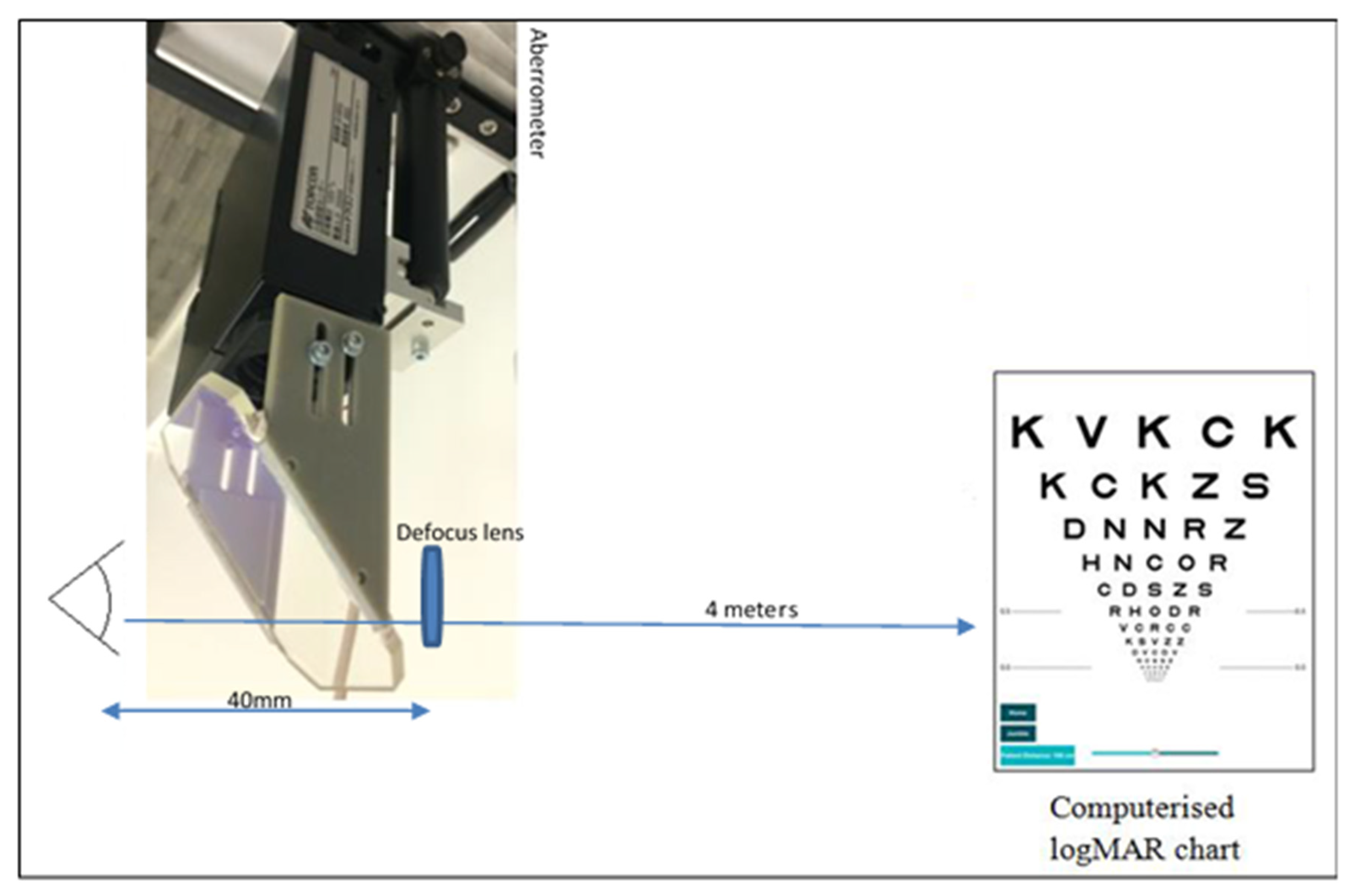
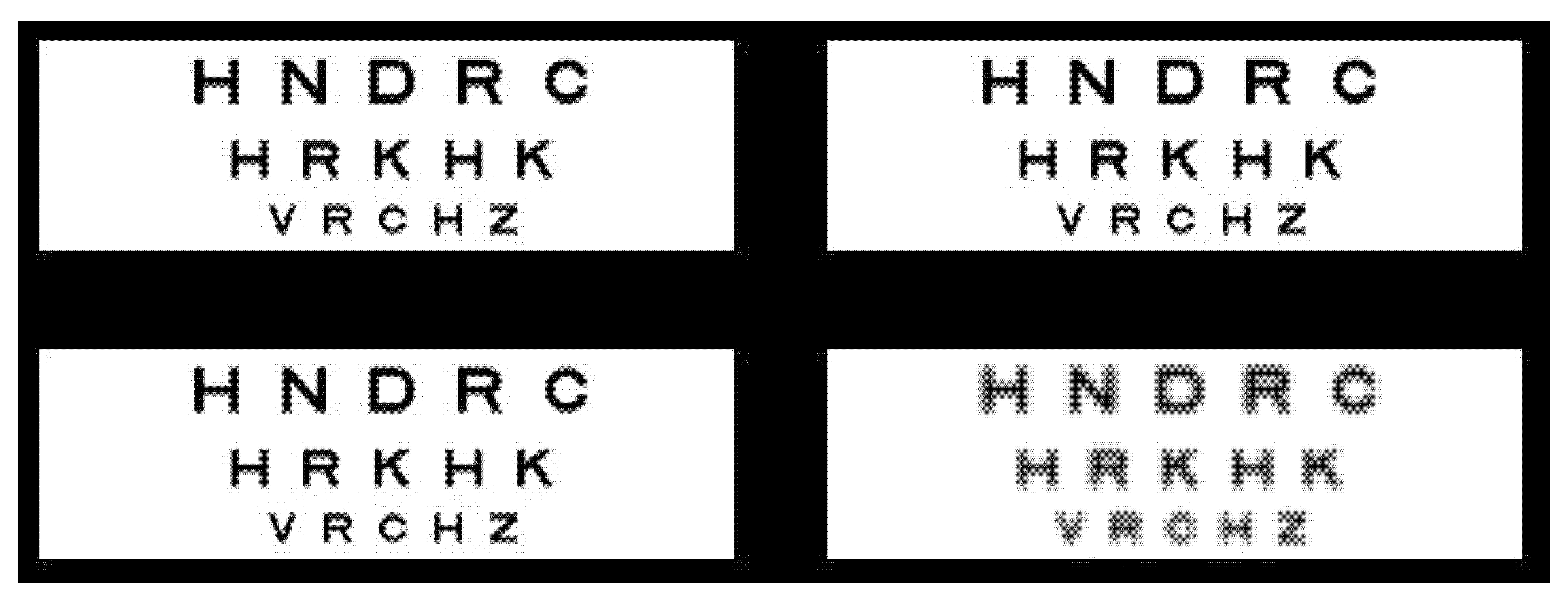
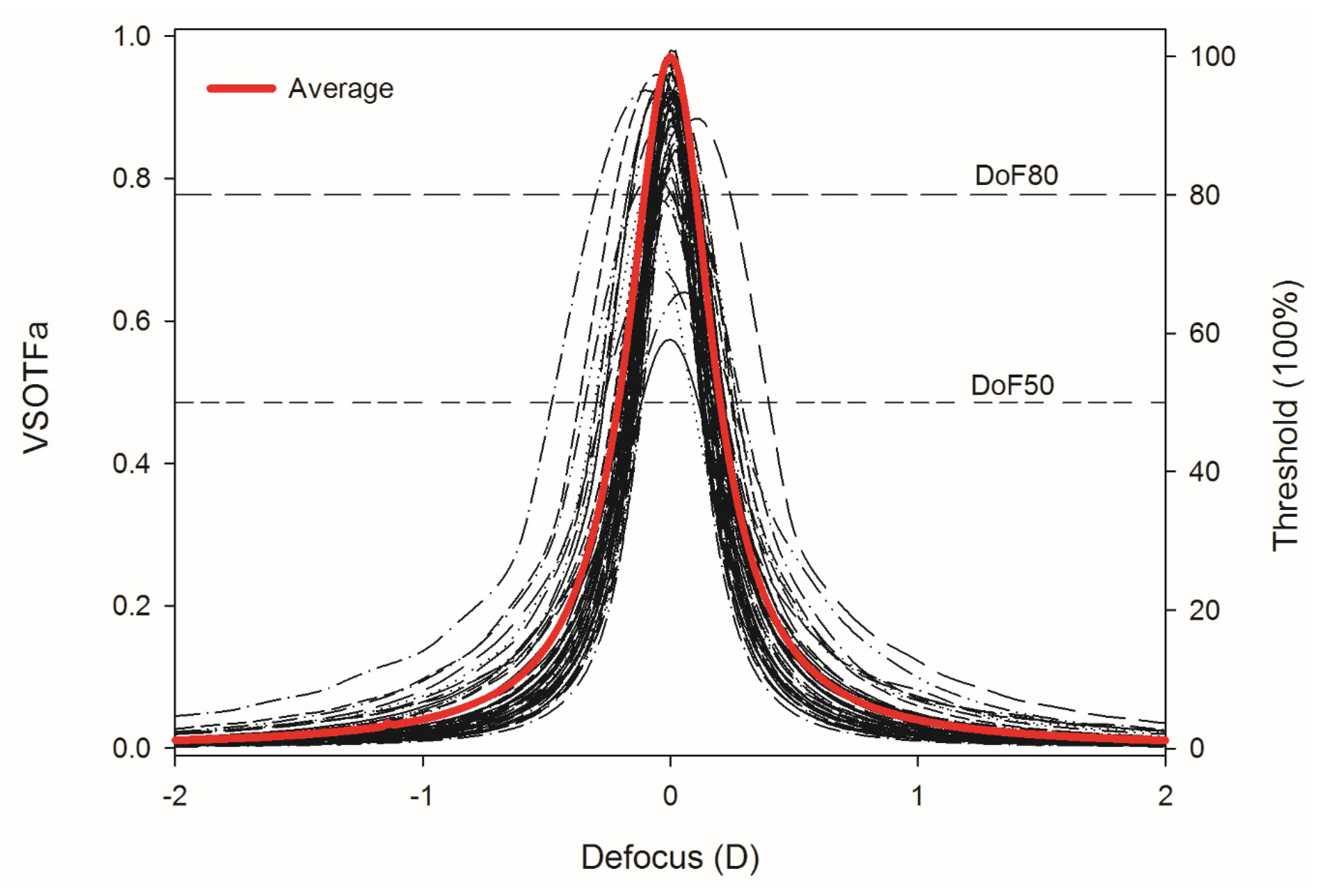
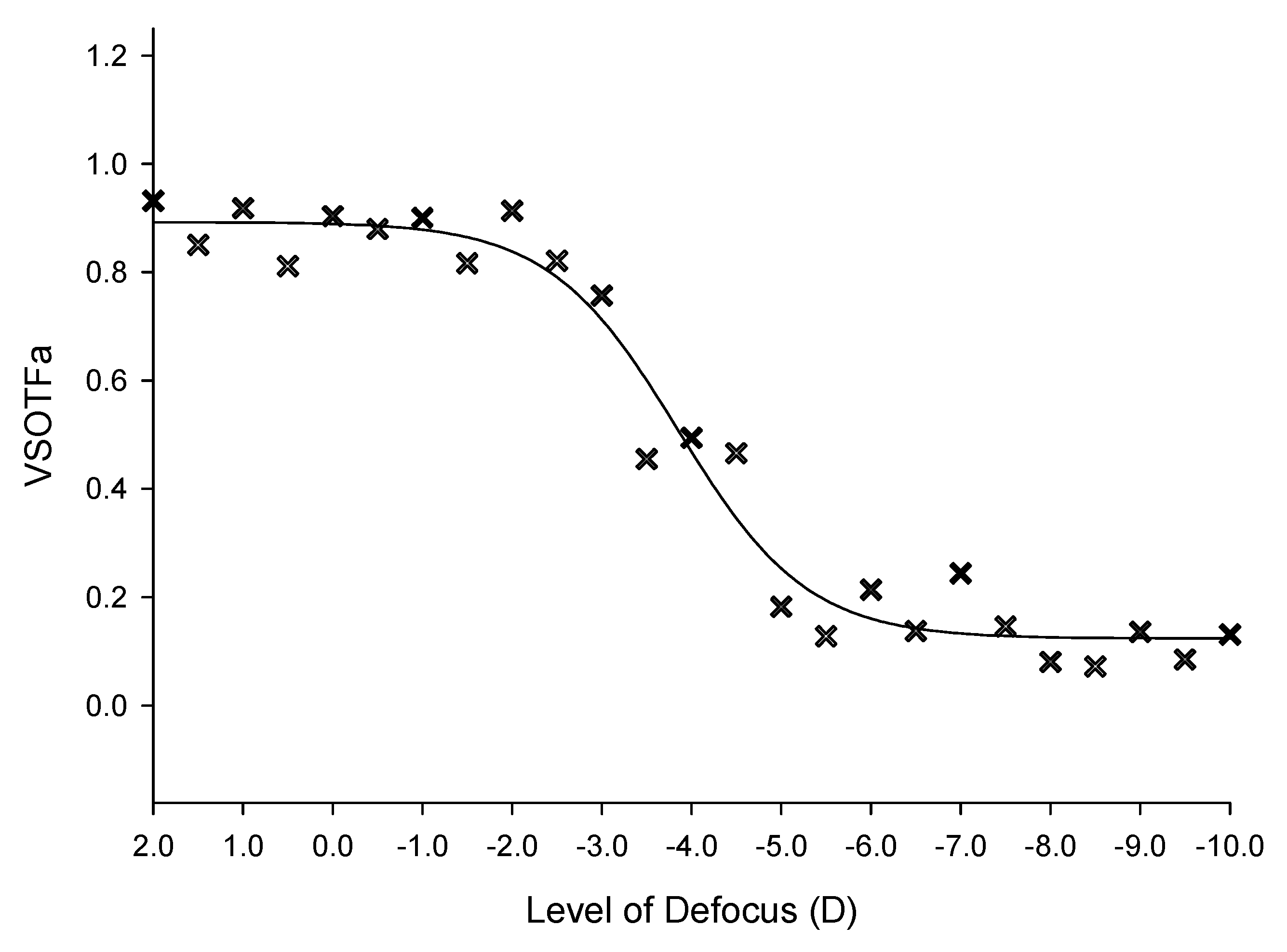
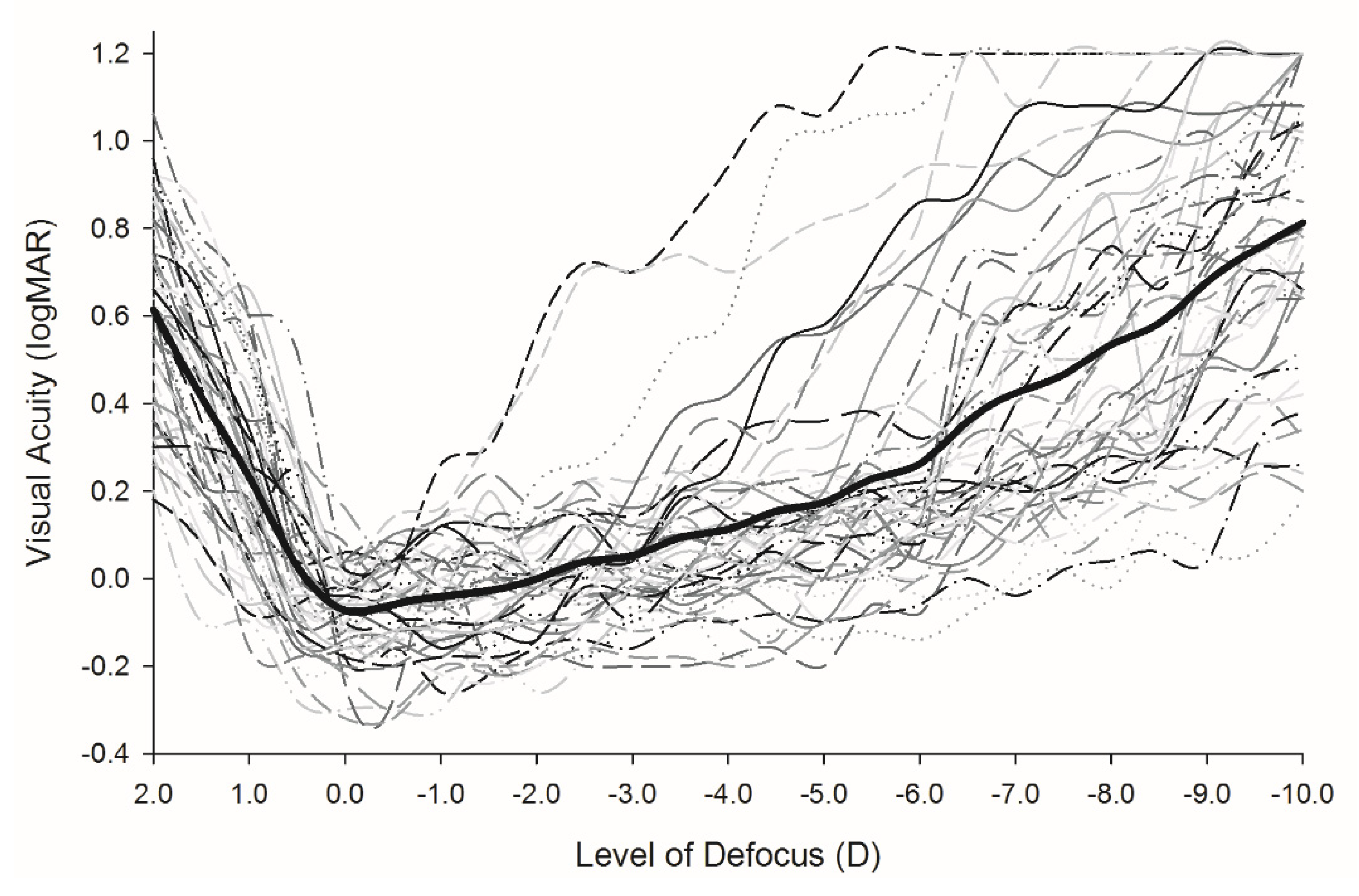

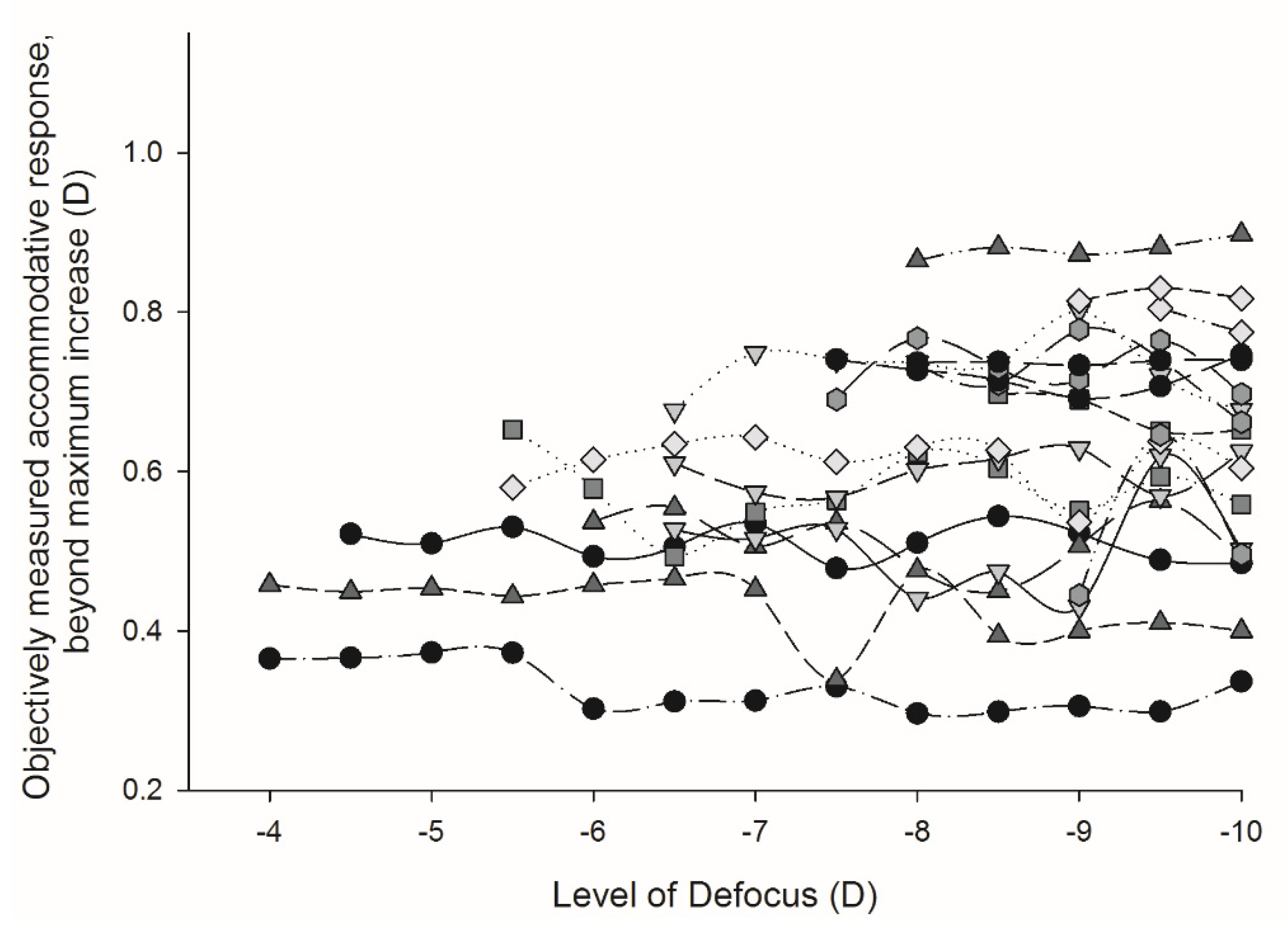
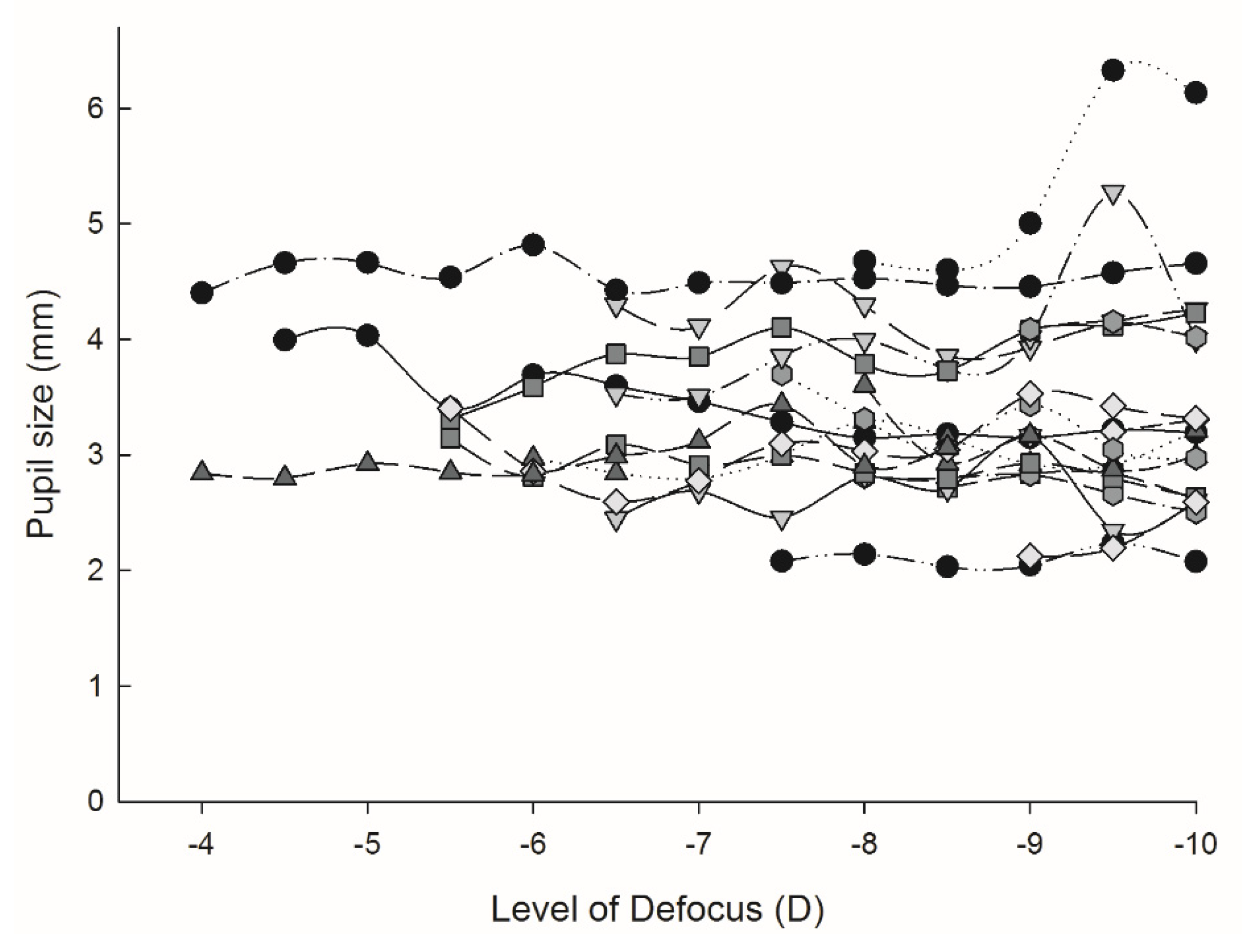
| Range of Clear Vision | Refractive Error | Tolerance to Blur | Ocular Aberrations | Age | Pupil Size | DoF Modelling | ||||||
|---|---|---|---|---|---|---|---|---|---|---|---|---|
| Objective | Difference | Higher order | Average spherical | 50% (max accom) | 80% (max accom) | |||||||
| Range of Clear Vision | Subjective | Pearson Correlation | 0.910 ** | 0.237 | 0.126 | 0.021 | −0.009 | 0.003 | 0.743 ** | 0.305 * | −0.311 * | −0.319 * |
| Sig. (2-tailed) | 0.000 | 0.101 | 0.389 | 0.905 | 0.949 | 0.984 | 0.000 | 0.035 | 0.031 | 0.027 | ||
| Objective | Pearson Correlation | −0.187 | 0.095 | −0.015 | 0.011 | 0.047 | 0.612 ** | 0.292 * | −0.299 * | −0.300 * | ||
| Sig. (2-tailed) | 0.199 | 0.517 | 0.932 | 0.941 | 0.752 | 0.000 | 0.044 | 0.039 | 0.038 | |||
| Difference | Pearson Correlation | 0.076 | 0.086 | −0.048 | −0.100 | 0.325 * | 0.032 | −0.030 | −0.044 | |||
| Sig. (2-tailed) | 0.603 | 0.625 | 0.745 | 0.497 | 0.023 | 0.828 | 0.841 | 0.765 | ||||
| Refractive Error | Pearson Correlation | −0.202 | 0.086 | 0.069 | 0.268 | 0.023 | 0.018 | 0.029 | ||||
| Sig. (2-tailed) | 0.244 | 0.555 | 0.643 | 0.063 | 0.879 | 0.904 | 0.843 | |||||
| Tolerance to blur | Pearson Correlation | 0.008 | −0.186 | −0.136 | 0.203 | −0.260 | −0.265 | |||||
| Sig. (2-tailed) | 0.964 | 0.293 | 0.437 | 0.249 | 0.137 | 0.130 | ||||||
| Ocular Aberrations | Higher order | Pearson Correlation | 0.460 ** | −0.042 | 0.117 | −0.026 | −0.045 | |||||
| Sig. (2-tailed) | 0.001 | 0.774 | 0.429 | 0.863 | 0.760 | |||||||
| Average spherical | Pearson Correlation | −0.053 | −0.021 | −0.015 | 0.001 | |||||||
| Sig. (2-tailed) | 0.719 | 0.889 | 0.919 | 0.993 | ||||||||
| Age | Pearson Correlation | −0.042 | 0.000 | 0.002 | ||||||||
| Sig. (2-tailed) | 0.776 | 0.998 | 0.987 | |||||||||
| Pupil size | Pearson Correlation | −0.885 ** | −0.898 ** | |||||||||
| Sig. (2-tailed) | 0.000 | 0.000 | ||||||||||
| DoF modelling | 50% (max accom) | Pearson Correlation | 0.995 ** | |||||||||
| Sig. (2-tailed) | 0.000 | |||||||||||
© 2019 by the authors. Licensee MDPI, Basel, Switzerland. This article is an open access article distributed under the terms and conditions of the Creative Commons Attribution (CC BY) license (http://creativecommons.org/licenses/by/4.0/).
Share and Cite
Dhallu, S.K.; Sheppard, A.L.; Drew, T.; Mihashi, T.; Zapata-Díaz, J.F.; Radhakrishnan, H.; Iskander, D.R.; Wolffsohn, J.S. Factors Influencing Pseudo-Accommodation—The Difference between Subjectively Reported Range of Clear Focus and Objectively Measured Accommodation Range. Vision 2019, 3, 34. https://doi.org/10.3390/vision3030034
Dhallu SK, Sheppard AL, Drew T, Mihashi T, Zapata-Díaz JF, Radhakrishnan H, Iskander DR, Wolffsohn JS. Factors Influencing Pseudo-Accommodation—The Difference between Subjectively Reported Range of Clear Focus and Objectively Measured Accommodation Range. Vision. 2019; 3(3):34. https://doi.org/10.3390/vision3030034
Chicago/Turabian StyleDhallu, Sandeep K., Amy L. Sheppard, Tom Drew, Toshifumi Mihashi, Juan F. Zapata-Díaz, Hema Radhakrishnan, D. Robert Iskander, and James S. Wolffsohn. 2019. "Factors Influencing Pseudo-Accommodation—The Difference between Subjectively Reported Range of Clear Focus and Objectively Measured Accommodation Range" Vision 3, no. 3: 34. https://doi.org/10.3390/vision3030034
APA StyleDhallu, S. K., Sheppard, A. L., Drew, T., Mihashi, T., Zapata-Díaz, J. F., Radhakrishnan, H., Iskander, D. R., & Wolffsohn, J. S. (2019). Factors Influencing Pseudo-Accommodation—The Difference between Subjectively Reported Range of Clear Focus and Objectively Measured Accommodation Range. Vision, 3(3), 34. https://doi.org/10.3390/vision3030034







